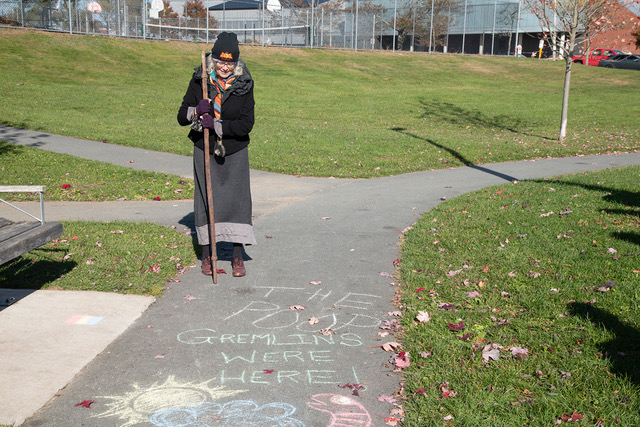
Image Credit: Barbara Lounder Nov. 2021 walking event “Corona Walker: The Commons.” This was the final and 7th walk in this project and involved 25 participants walking a route from the site of a 19th c skating rink; the public school location from that time; the Commons grazing area; and ending at Corona Walker’s gravesite. In this image I am walking backwards through a skate park that was built on the site of the old rink, carrying a walking stick that is a rusted vehicle axle, and encountering some amusing found texts. Photo by Robert Bean.
As part of the release of the hardcover/ e-book release of my book, Walking as Artistic Practice (softcover comes out in April!), I’m going to be publishing some brief interviews with the various artists, authors, researchers, creatives, collectives, and platforms whose art practice, written material, or other works I cite and mention.
My 14th interview in this series is with Barbara Lounder who lives and makes art in Dartmouth, Nova Scotia. Her studio practice is interdisciplinary and currently centres on walking. In addition to making and presenting her work, Lounder publishes and speaks on topics related to contemporary art, walking and other aspects of mobility, social activism and art education.
EM: First, thank you for chatting with me about your works. I cite your work, Pedestrian Detour (2010) in chapter eight (Activism) in the subsection on “Performances, Attire, and Props.” I also cite Stamp Sticks (2007) in chapter nine (Connections to Drawing) in the subsection on “Leaving Traces.” How would you describe these two works for people who might not be familiar with them.
BL: I did “Pedestrian Detour” during a residency at the Banff Centre for the Arts. The Centre was undergoing major renovations to infrastructure at the time, and many of the walking paths were off limits. I became interested in how pedestrian access was directed in this environment, using visual tools such as wayfinding signage and the high-visibility clothing of the work crews. “Pedestrian Detour” encompasses several different “sketches” or actions done in this context. In one, two participants walked through a busy construction zone wearing high-visibility blindfolds and using fluorescent walking sticks that I made. The walkers became moving points, like cursors, in the topography.
Stamp Sticks, also done as a sketch at the Banff Centre, was made in the Fall, when the trembling aspen trees display a vibrant yellow hue. The experience of seeing the leaves trembling on the trees, and then the brilliance of them after they fell to the ground, was stunning. I contrasted that immediacy of direct experience with the remote modes that we use in so much of everyday life and made a stamp with the @ symbol on it that I affixed to the bottom of a walking stick.
EM: What are your thoughts on walking as artistic practice?
BL: There are currently many different interests, motivations and approaches evident in walking as artistic practice, from highly personal and meditative approaches, to works that are socially engaged and activist in intent. What they all share is a foundation in embodied, multisensorial modes of movement, and an engagement with space as an enlivened context. My interests in walking as an artistic practice stem from my background making sculpture and installations, and my curiosity about the spaces between and around forms or subjects. These are the spaces where we walk, and they are charged with geology, history, memory, stories. And they are always changing as we move through them.
EM: Can you tell us about any recent or upcoming projects you are excited about?
BL: When the Corona Virus 19 (COVID 19) pandemic emerged, I became interested in a headstone in a local cemetery. It’s for a young woman named Corona Walker, who died in 1889 at the age of 18. I had seen the headstone many times, and it had been a point of reference in earlier walking art works, but the pandemic circumstances persuaded me to make it my focus. I did 7 public walking art events as part of Corona Walker, and quite a lot of researching and writing. Now I’m working on a manuscript about this project, with the hopes of publishing a book. I wrote a short, illustrated description of the Corona Walker project a few years ago, and it is online at https://www.livingmaps.org/barbara-lounder